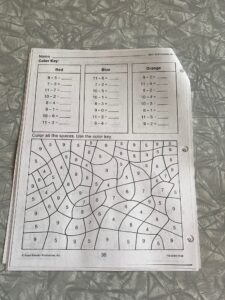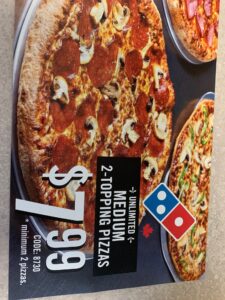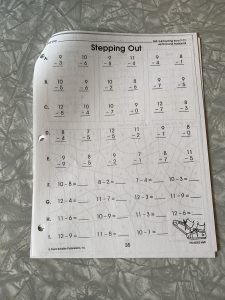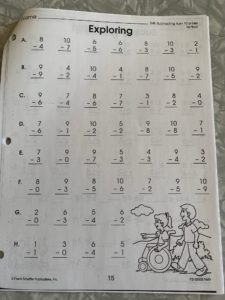Math
My goals for the month of June in Math are to review concepts already covered, reviews addition skills, continue learning subtraction.
Learn at Home Menu: Week 11
Lesson 1: Math facts
- In the Math duotang, please do addition facts plus 9.
- As the numbers are getting larger, the students might need blocks or counters to help them
- Continued practicing over the summer will help with speed and fluency of Math facts.
Lesson 2: less than, greater than and equal to
- All year long we have been talking about bigger than, smaller than or equal, but I have not introduced the official symbols to the kids yet. You can print the sheet below or you can practice on a sheet of blank paper.
Lesson 3: place value
- As I practiced with the students at school last week, I saw that some of the kids really understand how numbers are built and some as still learning.
- You can print the sheet below and work with your student or you can practice it on blank paper.
- This will be a bit of a challenge for the kids and will need parental help!
Learn at Home Menu: Week 10
Lesson 1: Math Facts
- Plus 7 in Math duotang
- As the numbers are getting larger, your child may need counters to help them. Buttons or legos work well!
Lesson 2: Subtraction Card Game
- Do the same game as last week but subtract this week instead of add.
- The students will most likely need a conversation about subtracting the smaller number from the larger number.
Lesson 3: Measurement
- Play around with creating something that uses measuring cups and spoons.
- It could be anything you like! One idea is make a batch of bubbles.
Recipe for Bubbles:
4 tablespoons water
2 tablespoons sugar
1 tablespoon dish soap
I would love to see a picture of your creation
Lesson 4: place value
- We are still reviewing how to take a number apart into hundreds, tens and ones
- You can cantinue practicing this on a piece of printer paper or you can print the sheet below
Lesson 5: money
- Go online to a website like “Toys R Us” or use an add you may find in your mailbox.
- Choose two things that you would like to buy.
- On a piece of paper, decide what coins you would use to buy the item
Show me a picture, please!
Learn at Home Menu: Week 9
Lesson 1: Math Facts
- Subtraction page in Math duotang called “Climbing High” It should be the last subtraction page not completed.
- The numbers are getting larger and students may need counters to help them solve these equations. Legos work great or buttons etc.
Lesson 2: Game
- We are heading back to a card game this week so pull out a deck of cards!
- You will need two players.
- Divide the deck of cards in half
- Player 1 lays down two cards face up and adds the numbers together.
- Player 2 lays down two cards face up and adds the numbers together.
- The player with the highest sum gets to keep both cards.
- If it is a tie, then each player keeps their own cards.
- All face cards and aces are worth 10.
Lesson 3: Skill Review – Skip Counts
- It is important in preparation for multiplication that are children can skip count by 2, 5 and 10 and also print those numbers in order.
- Please review the oral skip counts for 2, 5 and 10
- On a blank sheet of paper, have your child print the skip counts as they say them.
- If this is easy for them, then one time and done. If this is not easy, then do it several times.
Please send me a picture of your skip counts
Lesson 4: graphing
- the students really enjoy graphing
- Here is another graph
Lesson 5: Place value
- The children should be familiar with numbers up to 100 as they move into Grade 2. This week will be building numbers.
- On a blank piece of paper have the students write 10 random numbers up to 100 or more if they feel able.
- I would like them to be able to say the names of the numbers and also to tell you how many 10s and how many units
- ex: 79 – be able to say the name and to say 7 – tens and 9 – units
- Also, it is helpful if you give them a number and they need to write it, say it and deconstruct it.
Learn at Home Menu: Week 8
Lesson 1: Addition Fact Review – plus 6
- The addition review plus 6 page is in the Math duotang.
- If the children are running out of fingers or mental math strategies for the harder questions, it may be helpful to use lego or buttons as counters.
Please send me a picture of your addition practice
Lesson 2: Game- Fact Families
- This game is fairly straight forward. Roll two dice and print the numbers in the squares. Make fact families with the numbers
- Depending on how interested your child is, you can skip the negative number conversation and not do the second subtraction question. If they are interested, by all means enjoy some negative numbers!
- There are quite a few questions on the page, you can do less if you are finding that it is too much.
- If you do not want to print the page, feel free to do it on a blank sheet of paper!
Lesson 3: Skill Review – graphing
- We have already done a unit on graphing and the children really enjoyed it.
- They may need some help getting started as it has been awhile since we have graphed together.
- If you don’t want to print the page, you can graph all sorts of things in your house!
Lesson 4: Building 3D shapes
- The children really seemed to enjoy the building of the cube last week and some of the children were asking for another one.
- Here is a triangular prism to try!
- Students may colour the shape if they like to or draw patterns on it.
- They may need more direction with cutting, folding and gluing because if they do not take the time to cut it out carefully then it will be tricky to glue together!
Lesson 5: Place Value
- Place value is the platform that Math is built upon and it is a tricky concept for many of the students and has a real developmental component to it as it is so abstract to them.
- I would like them to have as much of an understanding as possible that a number like 49 is make up of 10 + 10 + 10 + 10 + 9
- If you do not want to print out the sheet, feel free to do the examples on paper like we did a few weeks ago!
Learn at Home Menu: Week 7
Lesson 1: Subtraction Fact Review

- The subtraction fact review page is found in their Math duotang.
- These are simple equations so should go quickly for the kids.
Lesson 2: Game: Going to Boston
- This is a new game for the students. They will definitely need parental support to add three numbers together, but I know they can do it!
- If you prefer not to print the score sheet, no problem, it can be written by hand.
- Here is a video of how to play!
Lesson 3: Skill Review: printing numbers to 100
- The sheet for Printing numbers to 100 is in the Math duotang
- The children have already done one sheet at home, so this sheet should be a breeze!
Please send me a picture of your numbers!
Lesson 4: Skill Review: creating a 3D shape
- Students have already learned the names and attributes of 3D shapes.
- Several weeks ago they did a 3D shape scavenger hunt at home
- This week we are going to create a cube out of paper. The children will probably need help with the folding and gluing
- Students can colour the shape if they like or draw pictures or patterns on it
- We will then carefully cut the shape out on the solid lines
- Students will fold on the dotted lines and put glue on the tabs
- Parents can help them stick the edges together to create a cube
Please send me a picture of your cube!
Lesson 5: Counting mixed coins
- The goal of this lesson is to count mixed coins.
- You do not need to print the paper. If you have some coins at home, you can just take some time to count differing amounts of coins together.
Learn at Home Menu: Week 6
Lesson 1: Addition Facts ( plus 5 in Math duotang)
Lesson 2: Game – Addition Yahtzee
- You do not need to print off the scoring sheet as you can reproduce it on a piece of paper.
- two dice are needed and two players
- Player 1 rolls 1 dice and doubles the number: example if you roll a 6 you double it -12 and then check off the 12 on the score card
- Player 2 takes a turn
- If you roll the same number again, you will not get to check off a number.
- First person to check off all of the numbers wins.
Lesson 3: Skill Review – measurement
- Our goal this week is to bake or cook something together and learn about the measuring cups and measuring spoons.
- Some ideas include: cookies, playdough or helping with dinner
Please take a picture of your creation!
Lesson 4: Write a Math Story
- In your Journal, please write me a math story. The children are familiar with this concept as we have been doing it all year.
- For example: Miss Evans fed Scout 4 carrots and then gave him 4 more carrots. How many carrots did Scout eat?
- Draw a picture of your story.
Lesson 5: What can I buy?
- Find a flyer from the mail or take a screen shot of something online that you would like to buy.
- On a piece of paper plan out how you can pay for it using coins. I suggest something that isn’t too expensive.
- Ex: If I wanted to buy a pizza for dinner that cost $7.99. I could pay for it with: $2 +$2 + $2 + $2

Learn at Home Menu: Week 5
- Subtraction Facts (“Stepping Out” located in Math duotang)
- Students have learned multiple strategies for subtraction facts. If they are struggling, I would suggest pulling out 20 small objects like lego pieces and using them as counters. This can be a big help if they get stuck or run out of fingers.

2. Game: Addition Facts
- Supplies needed: one deck of cards
- Divide the deck of cards between the players (2 or more players needed)
- players each lays down 2 cards
- add the two cards together ex: 2+7=9
- the player with the highest answer keeps all 4 cards
- if both players have the same answer, they keep their own cards
- to make it easier, all face cards and aces are 10
3. Skill Reveiw: Making Patterns
- Create three different repeating patterns with objects at home
- Take a picture of your patterns or make a short video explaining your patterns and send it to me!
4. Money: Counting nickels
- practice counting by 5s with nickels. Review the name “nickel” and the value- 5 cents
- You can use nickels at home if you prefer not to print the sheet.
5. Money: Put me in order
- practice putting money in order from smallest value to biggest value
- You can do this with coins at home rather than printing the sheet if you prefer!
Learn at Home Menu: Week 4
- Addition practice: plus 4 (located in the Math duotang)
- Game: subtraction facts
- Supplies needed: one deck of cards
- Divide the deck of cards between the players (2 or more players needed)
- players each lays down 2 cards
- subtract the smaller card from the larger card ex: 6-4=2
- the player with the highest answer keeps all 4 cards
- if both players have the same answer, they keep their own cards
- to make it easier, all face cards and aces are 10
3. Skill review: Place value
- If you would like to reduce printing, feel free to work on this concept on a piece of paper.
- My goal is that students will continue to work on their understanding of numbers up to 100.
- I would like the students to understand the number in the 10s place .
- An example: 13 can be broken down into 10 + 3 and 47 can be broken down into 10+10+10+10+7
Lesson 4: Counting dimes
- If you would like to keep your printing down, feel free to group differing numbers of dimes and have the kids count them.
- If you don’t have very many dimes, with help, the kids can put a dime under the paper and rub pencil on top to create the print of a dime and you can create groupings of dimes that way.
Learn at Home Menu: Week 3
- Subtraction Facts
- Subtraction facts page in Math duotang called “Exploring”

Please send me a picture of your Math facts.
2. Game: Roll it to the Top
- Two or more players needed and each player needs their own sheet. 2 dice also needed to play.
- Player 1 rolls both dice and adds them together. ex: 2+5 = 7. Player 1 colours in one square with 7 on it.
- Player 2 does the same thing
- To win you need to get to the top of one of the numbers.
3. Skill Review – Geometric Solids
- We have already learned about geometric solids (3D Shapes) so this is just a review.
- Do a scavenger hunt in the house looking for objects with the following shapes:
– Find 2 objects that are spheres (3D circle)
– Find 2 objects that are cubes (3D square)
– Find 2 objects that are cylinders (ex: toilet paper roll)
– Find 2 objects that are rectangular prisms (3D rectangle)
– Challenge: Find a triangular prism (toblerone box) or pyramid
4. Money Review
- Review the names of the coins: nickel, dime, quarter, loonie and toonie
- Review their values ex: 5 cents, 10 cents, 25 cents, $1, $2
- Skip count by 5 and 10
I will be testing these skills during our weekly chats.
5. Money Match Up practice sheet
Learn at Home Menu: Week 2
1. Subtraction facts 0-5
- We were just beginning subtraction in March before we left for Spring Break. Subtraction is easy for some and a new skill for others.
- Using recipe cards if you have them, have the students print subtraction facts on one side and the answer on the other to create their own flashcards. Our goal is to memorize 10 subtraction facts this week. If you do not have recipe cards, cut up a piece of printer paper. Let the children print the questions! Put the answers on the back so the students can try to say the answer without seeing it first!
- Suggested facts to learn: 5-4, 5-3, 5-2, 5-1, 4-3, 4-2, 4-2, 3-2, 3-1, 2-1
- If your student knows these facts already, move on to facts up to 10 ex: 10-8, 9-7 etc
2. Bears in a cave
- Bears in a cave is a game the children played in class. We have been adding more and more bears to our cave and we are now up to 10.
- The learning goal in this game is to understand ways to make 10.
- For a few of the students, this goal is already achieved. You can make it more challenging by adding some more bears up to 15.
3. Skill Review: Printing numbers to 100
- In the back of the Math duotang, you will find a practice sheet for printing numerals to 100. This will make the job much easier!
- We have done this in class a few times. The students are all able to print numerals to 100 without support. Although, there are a few students who may need help with a few number reversals.
- All 20 of use do this and correct it in under 30 minutes so I know that you can do this! Don’t let them fool you into thinking they can’t!
Please send me a picture of your numbers to 100!
Learn at Home Menu: Week 1
1. Addition Review +2
- In the back of the Math duotang, you will find some unfinished work. The first page is an addition page with +2
- All students can complete this in less than 30 minutes, many in 5-10
- Students are using multiple strategies: adding in their head, using their fingers or using manipulatives
Please email me a picture of the completed and corrected Math page.
2. Game: greater, less than or equal to?
- Students have played this game a number of times so it is not new. They will need a deck of cards.
- The game has two players and is similar to War: Divide the deck evenly, each player lays down a card. If your card has the bigger number you take your card and the other player’s card. If both cards have the same value, you each keep your own card. Reapeat until the deck is finished.
- To make things easier, all face cards, aces and jokers are worth 10.
- The winner is the person who ends up with the most cards.
- Play again looking for the smaller number.
3. Skill Review: Measurement
- In the pencil box that I sent home, there is a ruler.
- We have been practicing measuring things in our classroom. We have measured with rulers, our hands, paper clips, and our shoes.
- Review the two sides of the ruler: centimetres and inches and choose which measurement you would like to use.
- Challenge your student to wander around the house measuring things and looking for a specific measurement ex: Find something that is 2 inches long. When they find something that length, give them another measurement and have them continue searching.
- Keep measuring until they lose interest. 20 minutes or so.
4. Learning about Money: Part 1
- This is a brand new unit for us and we have not even begun to discuss it! Just a heads up!
- I am hoping that you have a change jar, some coins in your purse or that your child has a piggy bank.
- dump some coins out on the table and have your child begin to sort the change into piles of coins that are the same.
- look at each coin and talk about the differences in size, colour, decoration and value.
- Introduce the names of the coins: nickel, dime, quarter, loonie and toonie.
5. Learning about Money: Part 2
- Get out your pile of coins again and have your child sort them into piles again.
- Review the names of all of the coins
- line up 20 nickels and talk about the value of a nickel begin 5 cents, then count by 5s to 100. We have done this every day since September without the money! Have a discussion with your child that 20 nickels equals 100 cents or $1. Discuss the fact that 20 nickels has the same value as 1 loonie.
- line up 10 dimes and discuss the value of a dime to be 10 cents. Count by 10s to 100. Discuss that 10 dimes has the same value as 100 cents or 1 loonie.